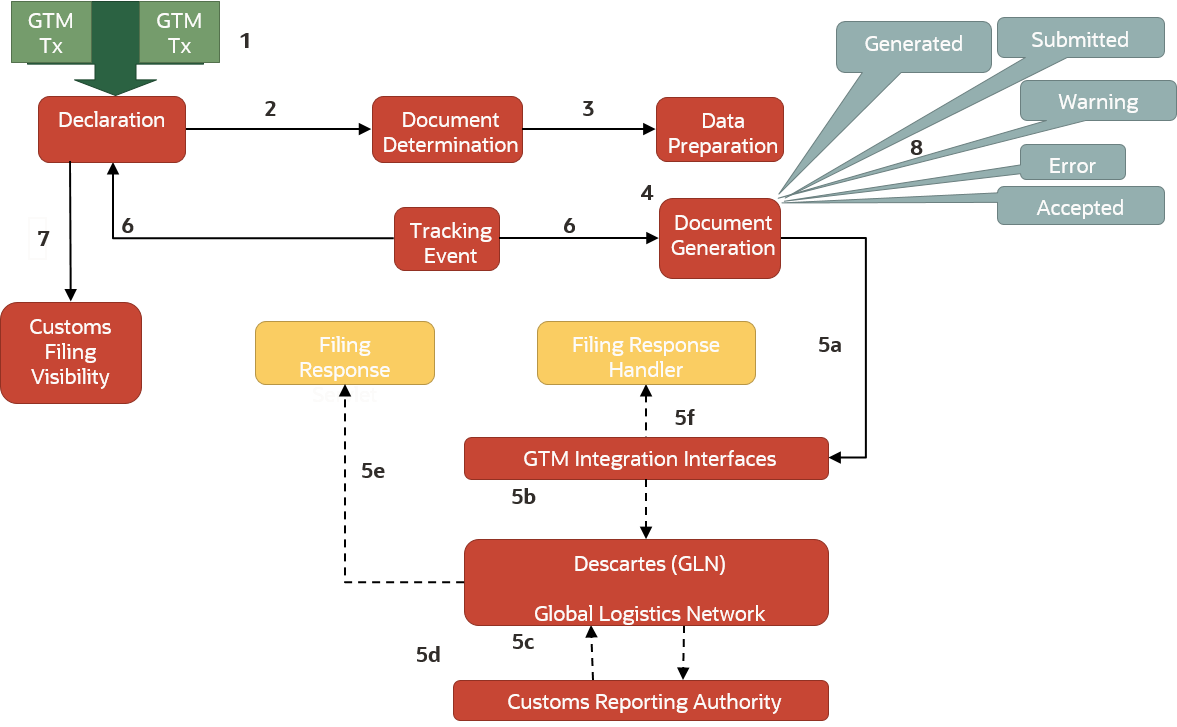Overview
This document is intended for Global Trade Management Cloud clients, Global Trade Management Cloud administrators, or Global Trade Management Cloud consultants who have an interest in creating and electronically filing trade documents for the purpose of reporting export declarations to trade regulatory authorities. This guide provides instructions on how to create filing documents and how to configure the integration components required for submitting the filing document to the US Trade regulatory authority, the US Census, via US Customs and Border Protection's (CBP) Automated Export System (AES).
The Customs Filing feature in Global Trade Management Cloud allows you to prepare documents for filing export declarations and subsequently transmit these documents to various customs reporting authorities, who could be national or other regulatory authorities, which govern trade compliance.
The process of customs filing broadly consists of the following pieces:
- Declaration Creation
- Filing Document Determination
- Data Preparation
- Filing Document Generation
- Filing Document Transmission
- Filing Response Processing (Optional)
- Filing Process Visibility

Declaration Creation
A declaration is the business object for all customs related activities. Declarations can be created manually or automatically. You can consolidate one or more trade transactions into a declaration. This consolidation can be done via UI and agent actions. All compliance screening activities should be performed on the trade transactions prior to consolidating them into a declaration. Once a trade transaction has been consolidated into a declaration, if a change needs to be made to the trade transaction that impacts the declaration, the trade transaction must first be removed from the declaration, then any changes to the trade transaction are applied, and finally the updated trade transaction should be re-added to the declaration.
Filing Document Determination
Customs regimes specify which documents need to be provided when filing export declarations, based on their regulatory requirements. You model the customs requirements as compliance rules. You run the compliance rules on the declaration to determine whether the declaration requires any documents and what the required document types are. The compliance rules are of the Control Category DOCUMENT. After the compliance rules are run, the required document types are assigned to the declaration and are listed on the Documents tab of the Declaration manager.
Data Preparation
Data preparation is essentially a task that involves converting the data from one form to another mainly for various reporting purposes. Data preparation can be run for multiple end-uses such as creating trade documents for customs filing, commercial invoices, etc. Typically the data such as quantities and currencies on the declaration use UOMs that are relevant to your operational environment. Users might want to show the quantities and currencies on reports and trade documents using different UOMs. Global Trade Management Cloud provides both UI actions and automation agent actions that help convert the quantities from one UOM to another. After the action converts the UOMs, the converted quantities are stored in the Reporting Quantities grid fields.
Filing Document Generation
If it is determined that a filing document is necessary after the data preparation, you can generate the filing document for the declaration by running the Generate Document action. When this action is run, the system retrieves all the information required to generate the document content, validates this information using the validation rules defined for the document type, and invokes the document creation mechanism. The action inspects all the lines belonging to the declaration, and selects only those lines that have been deemed reportable to be included in the filing document. Documents can be created via tools such as Oracle Analytics Publisher.
Filing Document Transmission
After the filing document has been generated for a declaration, you can transmit the filing document for that declaration using the File Customs action. This action transmits the filing document using the standard Transportation and Global Trade Management Cloud communication mechanisms. The action takes as a parameter, an external system. Transportation and Global Trade Management Cloud provides multiple integration options such as XML, web services, data queues, etc. to interface with the reporting authority systems.
Filing Response Processing
Inbound filing responses are modeled in Global Trade Management Cloud as Tracking Events. This allows filing responses, after entering Global Trade Management Cloud, to trigger notification or workflow, such as updating the statuses of the filing and updating the declaration with response codes and confirmation numbers.
Filing Process Visibility
To indicate where a declaration is in the lifecycle of customs filing, Global Trade Management Cloud provides a number of statuses. Global Trade Management Cloud also has a Customs Filing History grid on the Documents tab of the Declaration manager UI, where you can see how the statuses change as the declaration passes through various stages of the customs filing process. Users can define their own external statuses on declarations or on the filing document to monitor other conditions.